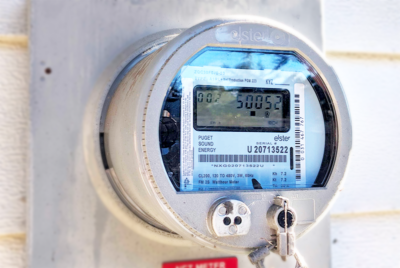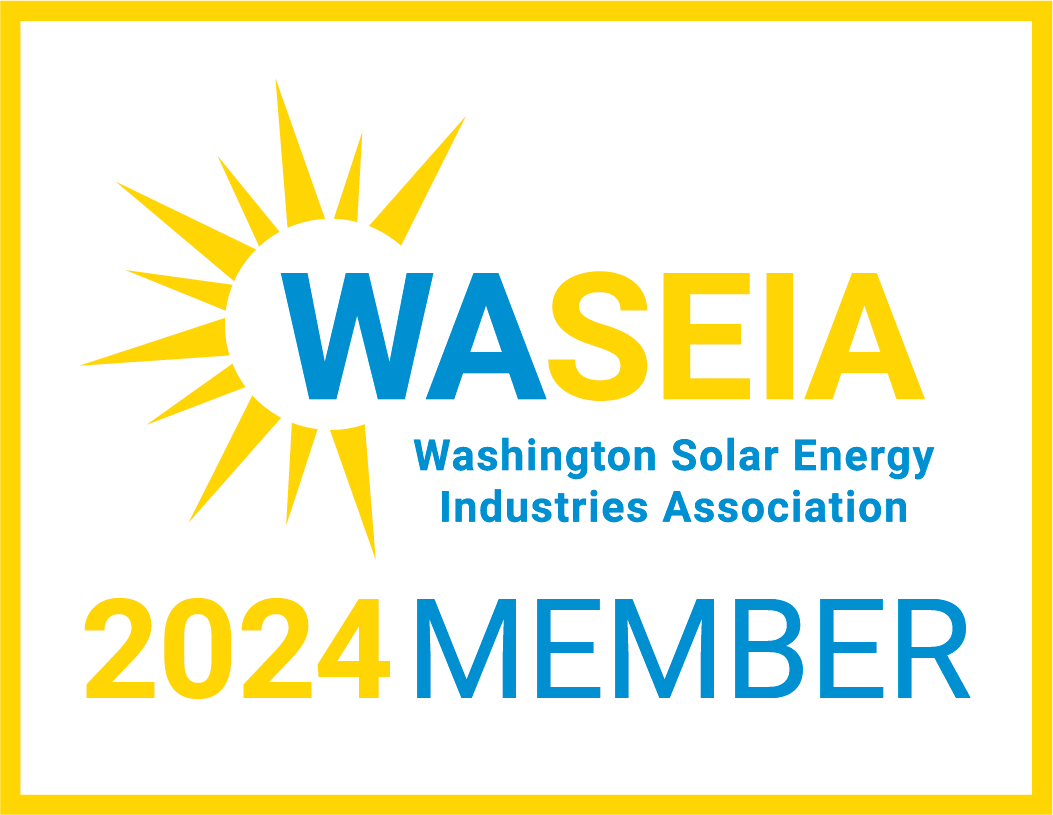
Puget Sound Energy net meter
Revised August 17, 2023 to reflect WSU Energy Program’s most up-to-date net metering capacity data.
Revised September 27, 2023 to reflect PSE’s updated net metering statement on Customer Connected Solar.
Whether you’re considering going solar or seeking to maximize the benefits of your existing system, net metering plays a pivotal role in making solar possible in the Pacific Northwest. Net metering allows solar owners to not only generate their electricity during our long and sunny summer days, but to also share excess power with the grid, earning credits that can be used to offset future electric bills.
Electric utilities in Washington are required to offer net metering to their customers, until the utility reaches a set cap. As our state’s largest utility, Puget Sound Energy’s cap equates to a generating capacity of about 177.6 MW, which far outpaces other utilities; however, PSE customers have risen to the occasion. At last count, PSE net meters over 155 MW of solar, meaning their net metering cap is on the horizon.
This article delves into the details of Washington’s net metering law, exploring how it works, the current status of Puget Sound Energy’s net metering program, and what we do and don’t know about future changes to net metering.
RCW 80.60: Washington’s net metering law
Under Washington State law, electric utilities are required to allow you to send excess electricity back onto the grid and credit your account in kilowatt-hours for the excess generation; this is called net metering (also referred to as 1:1, meaning when you export 1 kWh out to the grid, they give you a credit for 1 kWh which you can use at any time). This credit remains on your account until you use it, but the credit bank does reset each year on March 31st in accordance with state law. Any credit remaining at that time is zeroed out and the cycle starts again. (RCW 80.60.030)
This law requires utilities to offer net metering “until the earlier of either: (i) June 30, 2029; or (ii) the first date upon which the cumulative generating capacity of net metering systems equals four percent of the utility’s peak demand during 1996.” Utilities that reach this 4% cap have the option to continue to offer net metering at current 1:1 rates or to develop a different rate structure for new systems. (RCW 80.60.020)
Rate-change proposals from investor-owned utilities, such as Puget Sound Energy, must be reviewed by the Utilities and Transportation Commission before taking effect. Per RCW 80.60.020, “The commission must approve, reject, or approve with conditions a net metering tariff schedule pursuant to this subsection within one year of an electrical company filing. If the commission approves the filing with conditions, the investor-owned utility may choose to accept the tariff schedule with conditions or file a new tariff schedule with the commission.” The commission must also determine when customer-generators become ineligible for the net metering credit.
Every six months, each electric utility must provide information on the progress toward their 4% net metering capacity. The Washington State University Energy Program is required to make the following information for each utility publicly available:
-
- Each electric utility’s progress on reaching the cumulative generating capacity available to net metering systems
- Electric utilities that have provided notice of a rate or tariff schedule
- Electric utilities that have adopted a standard rate or tariff schedule
Puget Sound Energy’s Net Metering Status
As required by law, all available utility net metering data can be found in WSU’s Net Metering Report. Puget Sound Energy’s most recent numbers are:
-
- June 30, 2022: 67% of their required capacity
- December 31, 2022: 77% of their required capacity
- June 30, 2023: 87% of their required capacity
As of this writing, nothing has been published regarding what PSE’s net metering agreement will look like once they hit their cap. PSE’s website addresses the end of net metering in their Customer Connected Solar & Net Metering FAQs:
Updated statement from PSE on September 27, 2023: PSE is required by WA State Law to offer the current form of net metering until the state mandated threshold of participation is reached. Thanks to our net metering customers, we have nearly completed this requirement. We understand that customers may be concerned about changes away from our current net metering rate and program; and acknowledge the importance of planning ahead for energy management investments. PSE customers are still able to interconnect and apply to our net metering program under schedule 150. In the event of a new solar rate or tariff schedule being implemented to replace the current Net Metering program, we assure a minimum of 6 months’ notice before we stop accepting applications under the current net metering program (Schedule 150).
The full text of PSE’s Schedule 150 net metering agreement is available on PSE’s website, with specifics regarding the calculation of bill charges detailed on pages 4-5 under Terms and Conditions.
We have reached out to Leslie Moynihan, Product Manager, Customer Connected Renewables at Puget Sound Energy for additional official updates, and will revise this post with anything we receive.
An example of revised rates: Orcas Island Power & Light
Orcas Island Power & Light, or OPALCO, has already reached their 4% threshold and adopted a new rate structure in 2022. Since OPALCO is a member-owned cooperative utility, the board proposed and adopted a revised rate structure for new solar “member generators.” Per OPALCO’s website,
-
- The residential renewable tariff includes a renewable energy credit -$0.0990, a grid usage charge $0.0115, both applied per kWh. In addition to the usual charges, including service access charge, energy charge adjustment and energy assistance charge.
- These members power their usage from either their own solar system or, when the sun isn’t shining, from the OPALCO grid. When members use their solar power at the time it is produced – it is not run through the OPALCO meter and doesn’t show up on the bill.
- Anytime a member’s production exceeds their consumption, that excess power is put back on the grid. At the time power is put back on the grid, OPALCO buys that power at $0.0875. The OPALCO meter tracks that amount throughout the month, and this will show up as a credit on the member’s bill.
- When a member uses power from the OPALCO grid, they are charged $0.1201 at the time that the power is used. This shows up as a charge on the member’s bill.
For more information about OPALCO’s member generated power program, check out their post Quick Fact: OPALCO Solar Rate for residential members.
Three key takeaways
We understand—this is a lot of information to digest. Here are three clear takeaways regarding Puget Sound Energy’s net metering status:
-
- Is PSE getting close to reaching their net metering cap? Yes.
- Is there currently a date set for when net metering will change? No.
- Do we know what the current 1:1 net metering rate will change to? No.
If solar is on the horizon for you, we highly recommend initiating the process now, so your system can be installed under the current net metering program. This will enable you to lock in the current net metering retail rate regardless of when or how PSE adopts a revised rate structure for new systems.
As always, we encourage you to get multiple bids, do your homework, and make sure you’re an informed solar customer.















